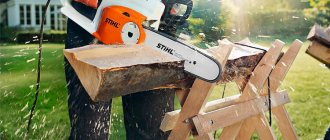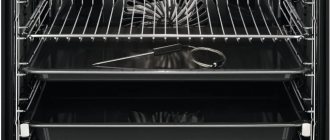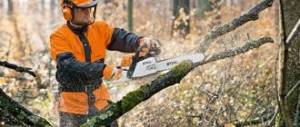Types of chains for chainsaws
Those who have dealt with sawing wood know that it can be sawed either along the grain or across it. Based on this, different types of chains for chainsaws are produced: for transverse or longitudinal cutting of wood. In both cases, the difference in material resistance will be significantly different. For longitudinal sawing, the teeth are sharpened at an angle from 5 to 15°. Cross cutting requires sharpening the tool at an angle of 25-35°. The figure below shows how the tooth sharpening angle is determined.
What type of saw element is can be found out from the markings on it; in addition, the sharpening angle is determined visually.
Chains for longitudinal sawing are used extremely rarely, because it is much easier to unravel the workpiece on a circular saw. Due to low demand, manufacturers of this tool do not particularly improve it, and it is quite difficult to find a chain for rip sawing on sale. Most chainsaw buyers choose a tool with a cross-cut type, and it is the most popular among both professionals and home craftsmen. But, before choosing a chain for a chainsaw, you should study the main parameters that affect the performance and quality of the tool.
Main characteristics
Any tool used to cut wood requires constant sharpening, lubrication and replacement. This also applies to the chainsaw chain. When purchasing such a part, it is very important to pay attention to its compatibility both with the device itself and with the upcoming work that needs to be done.
Chainsaw chain manufacturers use certain standard specifications when designing these products. This makes it much easier for buyers to select these devices.
The main characteristics of chainsaw chains include the following parameters:
- cutter sharpening angle;
- shape of cutting elements;
- height of the teeth relative to the stops.
In addition to the above technical characteristics, chainsaw chains differ in some other features. These include overall dimensions, thickness and length of these products. They are distinguished by such parameters as:
- the distance between the cutting elements is the so-called chain pitch;
- the total length of the chain is the number of its links;
- the thickness of the guide shanks relative to the device bus.
Before purchasing a chainsaw chain, you need to pay attention to all of the above technical characteristics. They influence how the device is used and its performance.
Existing step sizes
Chain pitch is a key parameter that requires special attention when choosing a cutting element for a chainsaw. It is measured in inches and is defined as the gap between the cutting links or the gap between the three rivets of the saw element. The following image clearly illustrates how chain pitch is determined.
Each saw has an individual chain pitch.
It is worth noting that the pro-class tool works with any type of circuit.
Chains with a certain pitch are always intended for units of a certain power, taking into account torque. Reducing the pitch not only reduces the performance of the device, but also reduces the load on the engine. Conversely, with a large step, the productivity of the device increases, but more power is required.
In addition, there is such a thing as the “aggressiveness” of the unit. In this case, we mean ease of control. The larger the step, the more force the teeth “tear” the wood. In addition, due to the large size of the cutting links, the width of the cut also increases, which means that the operator will need to make more effort to hold the device in his hands. Based on the above, it is not worth using a chain with a large pitch on a low-power unit, since this can render the device unusable.
0.325" pitch
This is the minimum step value, but nevertheless the most common. Saw elements with this pitch are usually installed on amateur and semi-professional units that have low power - in the range of 3-3.5 hp. This is enough to easily cut branches, fell thin trees, and carry out minor construction work. The 0.325-inch pitch chain operates smoothly, vibration-free, does not “rip” wood, does not overload the engine or fatigue the operator.
Pitch 0.375 or 3/8
The marking may look like a decimal fraction or an ordinary fraction. There is no difference between these notations: three divided by eight equals 0.375. The common fraction in the marking is intended to eliminate confusion between the numbers 0.375 and 0.325.
For this reason, there are times when it is difficult to find an element with a pitch of 0.375 inches on sale. If so, try looking for the same part marked 3/8.
These chains are installed on more powerful units - those with 4 hp. These saw blades can be used to cut down trees of medium diameter. Chains with a pitch of 3/8 inches are installed on semi-professional chainsaws and pro-class units.
Step 0.404
Saws with this pitch are installed only on professional units with a power of at least 5.5 hp. A saw with a pitch of 0.404 inches can cut down trees of any thickness, and the units for this cutting element have a large torque, which greatly facilitates human work.
It is important to know that the chain pitch always corresponds to the pitch of the sprockets, both driven and driven. It follows from this that if the documentation for the device indicates that it works with a chain with a pitch of 0.404, then you should not put a chain on a chainsaw with a pitch of 3/8. Before installing a chain with a different pitch, it is necessary to purchase a complete kit, including both the bar and both sprockets: drive and driven.
In addition to the above pitch values, there are two more: these are 1⁄4 (0.25) inches and 3⁄4 (0.75) inches. Saws with this pitch are not very popular among both professionals and home craftsmen.
Step size and tail thickness
The pitch of the links is one of the main criteria for choosing a cutting part for a gasoline saw. This is the distance between the three rivets or links of the element.
Different units are designed for chains with different pitches. The only exception is professional equipment, for which any cutting elements are suitable. The smaller the step, the lower the performance level of the device and the more load the engine is subjected to.
Experts also highlight such an indicator as the “aggressiveness” of the device . This means ease of control. A large step causes the teeth to begin to “tear” the material. In addition, a wide step increases the width of the cut; accordingly, the performer will be forced to make much more effort so that the device does not fall out of his hands.
The thickness of the tail (drive link) is another important parameter of the saw part. The thicker this element, the better and stronger the target. However, when selecting an element for work, you need to check the information specified in the operating manual of the device.
Thickness of the leading link (tail)
This parameter is the second most important when choosing a saw element. You should know that the tire width will vary on different brands of chainsaws. The drive links are also designed only for a certain type of tire.
Drive links come in the following sizes.
- 0.043” or 1.1 mm. This is the smallest leading link. It is usually installed in miniature circuits, which are intended for “weak” household units not intended for heavy loads.
- 0.05” or 1.3 mm. Although the difference with the previous example is insignificant, the cutting element is designed for more noticeable loads. Chains with a 1.3 mm link are most common among owners of household and semi-professional chainsaws; they are light in weight and quite reliable.
- 0.058” or 1.5 mm. This type of saw is no less popular than the previous one, but is no longer used only in semi-professional tools, but also in pro-class devices.
- 0.063” or 1.6 mm. Chains with such a tail thickness are more durable and are only used on tools for professionals.
- 0.08” or 2 mm. This size is the final size among the types of drive links. The chain is designed for long-term operation and heavy loads. It is not difficult to guess that the element is used only on highly professional chainsaws with high power.
As a result, the greater the thickness of the drive link, the stronger and better the chain, and the greater the load it can withstand. But when choosing a cutting element, you need to check the instructions for the device, which indicate what size tire can be installed on it.
Cutting depth and profile height
The depth of cut depends on how high the chain profile is. The higher the profile, the more the chain “bites” into the material, and as a result, the performance of the tool increases. With a low profile, thinner chips are removed and the chain does not sink as deeply into the material. Typically, the depth is adjusted by grinding off the stops that are located on each cutter.
The following profile sizes are available:
- high profile - 0.03” (0.762 mm);
- low profile - 0.025” (0.635 mm).
This information can be found in the documentation that came with your chainsaw. These types of profiles are installed on amateur and professional units. But you should know that professional-class tools cannot always be equipped with high-profile chains, and household tools are always equipped with low-profile cutting elements.
High-profile chains are the most productive elements, which means they have increased “aggressiveness” and, in addition, noticeable vibration. The latter significantly reduces labor productivity, as it does not allow working with the unit for a long time. Therefore, manufacturers have found a middle ground: with a large pitch, a chain with a low profile is made, and vice versa, if the pitch is smaller, then the profile is made high. These changes eliminate all side effects as much as possible, the unit begins to work with less “aggressiveness” and normal performance.
It’s hard to say which profiles are better. When choosing, you should always focus on the expected working conditions, the hardness or viscosity of the wood, etc.
Tooth height
The height of a chainsaw’s teeth is the maximum value of their cross-sectional profile. It can be completely different. This is primarily influenced by the power of the tool’s internal combustion engine.
There are two main types of teeth:
- height 0.762 mm;
- height 0.635 mm.
If the power of the internal combustion engine of a hand chainsaw does not exceed 3 horsepower, the manufacturer equips such a tool with teeth whose height is 0.635 millimeters. If the rated performance of the internal combustion engine exceeds 3 horsepower, the manufacturer equips such devices with teeth 0.762 millimeters high.
The height of the profile of the teeth of a chainsaw is exactly the parameter that you can easily change yourself at home. To do this, you need to grind off the cutting depth limiter. Such devices are located near each and every cutter of the saw chain.
Tooth geometry
The cutting links have 2 types of profile.
- Chipper, which is popularly called “sickle”. It has this name because of its crescent shape. Thanks to the chipper tooth geometry, the saw provides high productivity and is easy to sharpen, which does not require maintaining ideal angles. The disadvantages of this tooth geometry include the possibility of increasing the load on the unit and reducing the cutting qualities of the saw.
- Chisel, popularly called “seven” due to its similarity with the number of the same name. “Seven” is mainly used on professional-class tools, on chains with a pitch of 3/8 or 0.404 inches. The main disadvantages of this tooth geometry are difficulty in sharpening and rapid wear when dirt gets in.
Teeth geometry
Links can have not only different sizes and thicknesses. When choosing, it is important to consider the geometry of these parts. There are two tooth profiles :
- Chipper (“sickle”). Thanks to the crescent-shaped teeth, the saw achieves a high level of performance, is sharpened quickly and easily and does not require maintaining ideal angular geometry. The disadvantages of this design include increased load on the device and a decrease in the cutting properties of the chainsaw.
- Chiser (“seven”). Such parts are often used on professional tools. The disadvantages of these teeth include difficulty in sharpening and rapid wear due to trapped dirt.
The choice of a specific circuit depends on the upcoming operating conditions. But chipper cloves are the most popular because they cause fewer problems.
Tire size
In addition to the thickness of the tire, which was mentioned above, when choosing a chainsaw, one more parameter should be taken into account - the length of the tire. It is measured in millimeters or inches. The following tire sizes are often used: 11″, 12″, 13″, 14″, 15″, 16″, 18″, 20″, 21″, 22″.
For simple work, for example, cutting branches, cutting thin boards, you can use small tires - 11 or 13 inches. The chain on such tires accelerates to high speeds, which has a good effect on performance. The most universal tire sizes are considered to be in the range of 14-16 inches. In addition to using the unit as a lopper, the chainsaw can be used when harvesting firewood (sawing thin logs). To cut thick logs, install 18-22 inch tires. They are usually used on semi-professional and more powerful professional chainsaws.
You should not install a tire of a larger size than indicated in the passport for the unit, as this will inevitably lead to an increase in the load on the engine and, as a result, rapid wear.
Chain size
This parameter always depends on the size of the tire installed on the unit. If you accidentally purchased a chain that is smaller than your tire, you will not be able to fit it. If this element is larger than the tire size, you will not be able to tension it. Both options prevent the use of inappropriate chain sizes. They are usually indicated in inches and have the following values: 10″, 12″, 13″, 14″, 15″, 16″, 18″ and above.
The length of the chain is determined by the number of links. Links refer to the connecting links that fit into the groove of the bar, rather than the cutting teeth. When purchasing, you can indicate to the seller either the length of the part in inches or the number of links included in its composition. Some manufacturers, instead of length, indicate the number of links in the saw element. As a rule, this number does not depend in any way on the thickness of the tail, the pitch and the height of the profile. For example, a low-profile chain with a drive link thickness of 1.3 mm may consist of 72 links, 56 links, or some other number.
The order of the cutting links
In most cases, the order of placement of cutting elements can be of three types.
- With a pass. A connecting link is inserted after each cutting tooth.
- With half pass. A connecting link is installed between each pair of cutting links.
- Standard. Each cutting tooth is secured by two connecting links.
Cutting links are the main elements of the saw chain and are expensive due to the complex manufacturing process. Manufacturers, by changing the order of cutting teeth, reduce their number and thereby reduce the cost of the finished product. But at the same time, due to missing links, the efficiency of the tool is noticeably reduced, and the chain wears out faster.
Carbide chains
Pobedit is a very hard alloy, superior in strength to glass. Therefore, household glass cutters, various cutting metalworking and turning tools are made from pobedit, and it is also applied to saw chains of chainsaws. Pobedit is soldered onto the cutting links, where it acts as a strong cutting edge. But despite its hardness, this alloy is brittle.
The service life of chains tipped with Pobedite significantly exceeds the service life of standard cutting elements. Carbide chains are used for sawing frozen and hard wood, as well as in emergency situations where reinforced or regular concrete needs to be quickly cut.
The disadvantages of carbide chains include their high cost, which is several times higher than the price of conventional cutting elements.
Chains for chainsaws with pobedit tips are used very rarely in amateur practice, since they are intended for semi-professional and professional tools with good power and high torque.
The best brands of chainsaw chains
Based on reviews from the owners of these units, a rating of chains for chainsaws has been compiled. Below are the manufacturers that make the best chainsaw chains.
- Stihl is a very famous Swiss brand that produces saw chains made of high-strength chromium-nickel steel. They do not stretch when heated like regular ones. This is achieved through the use of a special hot riveting method in production. In addition, this manufacturer has patented a lubrication method - “grooves”, which are supplied to all drive links.
- The company does not design chains, but manufactures them using the best patented technologies. Thanks to this, high quality products are achieved. The company also provides a wide range of services to customers, providing warranty service for its products. In addition, the company's clients have the opportunity to purchase original spare parts for mechanisms.
- Oregon is a division of Blount Inc. The company is considered one of the best among companies producing saw elements for chainsaws. Oregon also produces various accessories and spare parts for instruments of other well-known brands. The sawing elements of chainsaws are made of a special patented alloy, and a chromium alloy is applied to the teeth. To facilitate the sharpening process, marks are placed on the teeth indicating at what angle this operation must be performed. In addition, the chains have a system that reduces vibration and an original design, thanks to which the lubricant is distributed evenly.
- Carlton is a company from America. All chain elements from this manufacturer have increased hardness because they undergo shot blasting at the manufacturing stage. The cutting links have a long edge, making it possible to perform a large number of sharpenings.
- Windsor. The company has patented a super-strong alloy that is highly heat-resistant and does not stretch. Windsor saw elements use stamped links and sealed rivets to ensure high reliability.
- The chain is made of alloy steel with chrome-plated teeth. The latter are sharpened in a special way, and a hypoid lubricant is applied to the chain, facilitating the sawing process. The company also uses the shot-peening method in the manufacture of chains, which increases the strength of the links.
Manufacturers
Currently, chainsaw chains from various manufacturers can be purchased in construction stores. The most popular among them are:
- Stihl (Germany);
- Oregon (United States of America);
- Husqvarna (Sweden);
- Dolmar (Germany).
chainsaw chain
The most popular chainsaw chains are from brands such as Stihl and Oregon. They are of good quality and reliability. In third place are devices from Husqvarna. This equipment manufacturer does not independently produce chainsaw chains. He places orders from the American brand Oregon. Less popular are Dolmar products. Despite this, their quality and reliability of use are practically no different from those of other circuits.
Inexpensive Chinese consumable spare parts for chainsaws can be bought from such Chinese brands as:
- Rezer;
- Champion;
- Forza et al.
Chainsaw chains from the above companies are characterized by rapid stretching. In addition, they become dull over a relatively short period of time. Despite this, such products still enjoy corresponding popularity and demand among buyers.
- Related Posts
- Husqvarna chainsaws - design, repair, model review
- Chainsaw Stihl - review, device, Malfunctions - causes and solutions
- How to choose a chainsaw
« Previous entry











